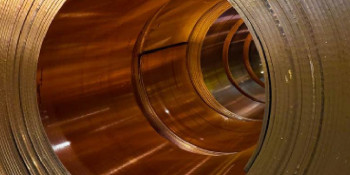Q&A Forums
Roof condensation with open cell in New England Post New Topic | Post Reply
| Author | Comments |
|---|---|
|
Eric Machemer
Posted: Jan 10, 2009 08:45 AM
|
Roof condensation with open cell in New England
Here's the scoop:1800's northern Massachusetts farm house recently renovated (about 3 years ago). Basement floor is 1/2 concrete slab w/ 2" polystyrene under and 1/2 dirt crawl space with no poly ground cover. Homeowner says he has been monitoring indoor humidity and that it runs about 40%. About 600 sq ft of roof deck roughly over the same area as the dirt crawl space has the following assembly: 2x12 rafters with 1/2" plywood roof sheathing 2" polyiso with foil face both sides was cut into the rafter bays and installed directly against the interior side of the roof sheathing. 8" of open cell foam was sprayed directly on top of the polyiso. Please note that the polyiso started at the fascia line and stopped about 18" before it reached the ridge. Nobody seems to know why the polyiso board stopped short of the ridge like this. There are several areas in this attic where you can see water spots on the floor from dripping. I dug a hole through the open cell near the ridge and felt the plywood sheathing. It was very cold and had a fairly thick layer of ice crystals. I then came down the roof a couple of feet and dug another hole through the open cell foam and was able to feel the foil faced polyiso. It was warm and dry. My obvious first inclination is that the installation of a poly vapor barrier over the dirt crawl space would fix the problem, but I wonder if the foil faced iso board, being a vapor barrier on the cold side, would still pose a problem. I would like to recommend that ALL the insulation be stripped out of the rafter bays and then install 4" of closed cell directly to the roof sheathing with a thermal barrier covering. I would imagine that this would solve the problem completely, but obviously at quite a price. Does anyone have any thoughts or an elegant simple solution that is a bit less costly? |
|
SprayFoamSupply.com
Posted: Jan 10, 2009 06:48 PM
|
Why not just rip out the open cell in the top 18" where there is no iso board? Then put iso board or 2" closed cell and respray with open to be the same as the rest of the roof? Are you confident that the roof in not leaking? Are you confident that the water is from condensation from the top 18"? When the job was first done, they probably ran out of isoboard and figured that it would be OK. George |
|
Eric Machemer
Posted: Jan 11, 2009 08:21 AM
|
George, Thanks for your response. Would you think that condensation may be present between the Iso board and the roof sheathing when we get lower down the roof? What about the foil vapor barrier still being in place on the cold side? I would say that the roof does not leak as it is a very basic roofline, fairly new and installed by a very reputable guy (I know the guy personally and he is the one that called me in to have a look). Also, this problem only occurs in the winter. Based on this, I can't imagine where else the moisture would be coming from. Homeowner installed the Iso board per foam contractor's recommendation. This includes leaving the board short of the ridge by 18". Homeowner says the foam guy told him to do this. Homeowner cannot recall the reasoning. My concern is going in and performing the work if I am not 100% sure that it will work. If it were my house, I would probably try your suggestion, but even this amount would be a little costly when you consider how little foam there is to do and the fact that it would require visits with 2 different rigs, dragging hose to the 3rd floor attic through a very nice house and setting up ventilation to keep fumes out of the living area. |
|
Jim Coler
Posted: Jan 11, 2009 02:32 PM
|
The Iso board is likely not in direct conatct with the entire underside of the roof which leaves an airspace and may allow condensation within this space as it gets hot from solar heat gains and cold from fall/winter/spring nights. Is the top of the wall possitively sealed in so no warm air comes up and gets behind the iso board? If there was intentionally an airspace left above the boad, then do like George says and continue that venting cavity all the way to the ridge and make sure you soffit and ridge vents which are open. If there are no accommodations for venting, then tear it out and foam it solid to the roof deck with open or closed cell. You just have to make sure it's in direct contact with the roof deck - most likely not the case with the foam board. The problem is not likely the open cell foam, but the cavities behind the foam board and you cna see the problem that is occurring because the moisture can come through the open cell foam. |
|
Eric Machemer
Posted: Jan 11, 2009 05:59 PM
|
There is no soffet or ridge vent. Iso board was placed directly against roof sheathing and was not sealed aound edges before spray foam was installed. I would tend to guess that moisture works its way between iso board and roof sheathing. If poly ground cloth over dirt crawl space keeps humidity levels quite a bit lower, would this smaller amount of moisture keep condensation in check? |
|
Edward Brassington
Posted: Jan 12, 2009 09:39 PM
|
You make no mention of a vapour barrier. In a cold climate open cell foam requires a vapour barrier on the warm side of the insulation. If there are Ice crystals on the roof sheathing then this is warm moist air migrating through the insulation and condensing on the cold roof deck. It is quite possible that the open cell foam is wet. If so it should be removed. Also the Iso board is probably acting as a vapour barrier, except it is on the wrong side of the insulation. I aggree with your plan to remove the open cell and Iso board and replace with closed cell directly on roof deck. Good luck. |
|
Jim Coler
Posted: Jan 13, 2009 10:14 PM
|
I agree with foam maker about the Iso board creating a vapor barrier to the cold side. Moisture is likely being drawn to the back side of this Iso board through the wood because of the increased temperatures in the air pockets behind the iso boards. You need ot make sure the foam is stuck directly onto the roof decking to prevent this condition. Open or closed cell will work in this situation and a vapor barrier may not be needed depending on the product used,geographic zone, the perm rating of the product and the thickness applied. Closed cell is also an option but not required as some may imply. |
|
JohnPeters
Posted: Mar 22, 2009 04:32 PM
|
I don't necessarily think that the crawl space relative humidity or environmental conditions plays any role in this roof deck condensation problem. Unless this space has balloon framing from the crawl space to the attic? On a side note - Is there a ridge vent? It seems like the running theory here is that there should be a vapor "retarder" on the warm side of the insulation and that the foil faced iso is acting as a vapor barrier on the wrong side of the roof deck assembly. If that is the case then you should be seeing condensation on the foil faced iso right? Because the moisture drive is pushing through the foam and stopping at the foil. Another side note...Is there a bathroom vent venting in the attic space? I work in New England, so I am up against issues like this often. It is my understanding that the only time condensation occurs on roof deck sheathing is when warmed air being created inside the thermal envelope escapes and hits the cold substrate of the roof deck sheathing. The air barrier that SPF provides to the exterior of the envelope also prevents warmed air in the envelope from hitting the exterior sheathing. Warmed air is inherently moisture latent. If your dealing with a 2x12 cavity...why put iso board in there? You only have 8" of 0.5 lb installed right? If the customer wants more r-value, you should have given them 10 inches of foam without the board. I personally think that even though the board side does not show signs of condensation, it is causing this problem because of the air space between the board and roof deck sheathing. I also personally think that foam should always adhere to the substrate it is sprayed on to. Foam board creates an air barrier and puts the vapor barrier on the cold side. I also believe that vapor barrier (aka. retarders) are unnecessary and should be banned in climate zone 5. my $.02 jp |
|
Posted: Mar 23, 2009 06:25 AM
|
i would guess they put the iso board in there in case "we have to put down new sheeting sometime"....a layer of interference so to speak,,and theygot just that a "layer" of interference,,,, hot meets cold condensation occurs,,when the dewpoint is met in the wall cavity,,,it is at a point of saturation that will allow it to condensate on the next available physical surface,,,the airspace between the board and the deck is a good example here,,,, i modeled this roof system(program looks at it as a wall,,but)used burlington VT weather data,,anyway this system showed 2 grains of cond per sq ft per day in this system,,,dewpoint met in the foam,,as it should be,,,but maybe we have the "airspace" with the boardstock "pressed" in there,,, i added more urethane foam to the model..same results,,went out to 12",,,same results,,,added more boardstock,,,same result,,, fyi: 1-ounce = 437.5 grains 1-cubic foot = 7.4805 US gallons 1-pound of water = 15.432 grains 1-gallon of water = 0.134 cubic feet 16-ounces = 7000 grains so you can see the minescule amount of moisture in this system,,, i too believe there is much to much VB vodoo goin on,,,VB's came to be cause tradional insulation does not effectively stop the transfer of hot to cold,,, that bein said,,, i suggest a vb in sidewalls with any depth oc and cc less than 1",,there is modeling to show a large reduction in the potential for moisture into this wall cavity with the vb in place,,,it is suspenders over the belt kinda thing,,,, i dont see vbs goin on the lids much,,, anyone consider the vb retarding properties of lets say 12mil of paint/primer???(3 coats for those of you from loma linda) its hugh,,, (i stacked more 1" board stock in my model,,and it didnt change a thing,,,the dewpoint stayed right at the foam to sheating interface,,its a math thingy,,you know that ???curve thingy) (if a drainage plane is present,,and the material can dry,,,the oc foam will return to its original physical properties,,so i wouldnt neccesarily be in a hurry to remove it here,,,) john,,if they remove the mandate for vb's in cold climates there will be many wall system failures with the traditional insulation products,,they just arent thermally efficient in the wall cavity depths we are building,,,not the case with foam systems,,i concur,,,but ours is not the only systems being installed,,,,my modeling can show a 100x reduction in the amount of moisture introduced to a wall cavity with the vb present (non closed cell wall systems here folks),,, ,,,just another manic monday |
|
michael beres
Posted: May 31, 2009 11:20 PM
|
I enjoy reading your work and would appreciate any and all opinions regarding selection of foam type and especially location and type of vapor barrier(or no vapor barrier) for my own house, walls and roof. i am long on theory and short on practice and plan to contract the foam job, doing the rest of the house myself. it is 3000 sq ft. simple rectangle, with stud walls, drywall interior, vinyl or hardiboard siding, slab over foam for hydronic radiant heat, 1'2 (planned unvented based on what i've read here.) attic and 1'2 cathedral ceiling. climate is mixed charleston, west virginia. thank you, with respect, mike. |
|
Posted: Jun 02, 2009 07:26 AM
|
hey man,,, start a new topic thread with this,,, lots of knowledgeable folks out there,,,, lets see where this goes,,,, |




























